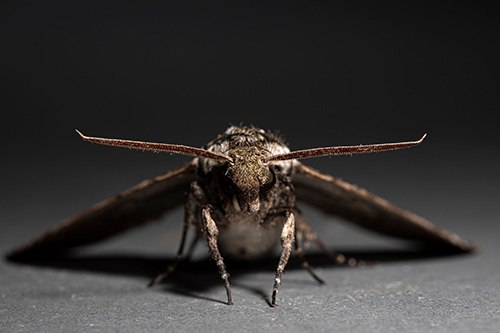The palm-sized device could one day be engineered to track down explosives and gas leaks or could even be used by medical laboratories to detect disease
Here’s a technology breakthrough with many implications for diagnostics and clinical laboratory testing. Researchers at the at the University of Washington (UW) are pushing the envelope on what can be achieved by combining technology with biology. They developed “Smellicopter,” a flying drone that uses a living moth antenna to hunt for odors.
According to their published study, the UW scientists believe an odor-guided drone could “reduce human hazard and drastically improve performance on tasks such as locating disaster survivors, hazardous gas leaks, incipient fires or explosives.”
“Nature really blows our human-made odor sensors out of the water,” lead author Melanie Anderson, a UW doctoral student in mechanical engineering, told UW News. “By using an actual moth antenna with Smellicopter, we’re able to get the best of both worlds: the sensitivity of a biological organism on a robotic platform where we can control its motion.”
The researchers believe their Smellicopter is the first odor-sensing flying biohybrid robot system to incorporate a live moth antenna that capitalizes on the insect’s excellent odor-detecting and odor-locating abilities.
In their paper, titled, “A Bio-Hybrid Odor-Guided Autonomous Palm-Sized Air Vehicle,” published in the IOPscience journal Bioinspiration and Biomimetics, the researchers wrote, “Biohybrid systems integrate living materials with synthetic devices, exploiting their respective advantages to solve challenging engineering problems. … Our robot is the first flying biohybrid system to successfully perform odor localization in a confined space, and it is able to do so while detecting and avoiding obstacles in its flight path. We show that insect antennae respond more quickly than metal oxide gas sensors, enabling odor localization at an improved speed over previous flying robots. By using the insect antennae, we anticipate a feasible path toward improved chemical specificity and sensitivity by leveraging recent advances in gene editing.”
How Does it Work?
In nature, a moth uses its antennae to sense chemicals in its environment and navigate toward sources of food or a potential mate.
“Cells in a moth antenna amplify chemical signals,” said study co-author Thomas Daniel, PhD, UW Professor of Biology, in UW News. “The moths do it really efficiently—one scent molecule can trigger lots of cellular responses, and that’s the trick. This process is super-efficient, specific, and fast.”

Because the moth antenna is hollow, researchers are able to add wires into the ends of the antenna. By connecting the antenna to an electrical circuit, they can measure the average signal from all of the cells in the antenna. When compared to a metal oxide gas sensor, the antenna-powered sensor responded more quickly to a floral scent. It also took less time to recover between tracking puffs of scent.
Anderson compared the antenna-drone circuitry to a human heart monitor.
“A lot like a heart monitor, which measures the electrical voltage that is produced by the heart when it beats, we measure the electrical signal produced by the antenna when it smells odor,” Anderson told WIRED. “And very similarly, the antenna will produce these spike-shaped pulses in response to patches of odor.”
Making a Drone Hunt Like a Moth
Anderson told WIRED her team programmed the drone to hunt for odors using the same technique moths employ to stay targeted on an odor, called crosswind casting.
“If the wind shifts, or you fly a little bit off-course, then you’ll lose the odor,” Anderson said. “And so, you cast crosswind to try and pick back up that trail. And in that way, the Smellicopter gets closer and closer to the odor source.”
However, the researchers had to figure out how to keep the commercially available $195 Crazyflie drone facing upwind. The fix, co-author and co-advisor Sawyer Fuller, PhD, UW Assistant Professor of Mechanical Engineering told UW News, was to add two plastic fins to create drag and keep the vehicle on course.
“From a robotics perspective, this is genius,” Fuller said. “The classic approach in robotics is to add more sensors, and maybe build a fancy algorithm or use machine learning to estimate wind direction. It turns out, all you need is to add a fin.”

Other Applications for Odor Detecting Robots
While any practical clinical application of this breakthrough is years away, the scientific team’s next step is to use gene editing to engineer moths with antennae sensitive to a specific desired chemical, such as those found in explosives.
“I think it is a powerful concept,” roboticist Antonio Loquercio, a PhD candidate in machine learning at the University of Zurich who researches drone navigation, told WIRED. “Nature provides us plenty of examples of living organisms whose life depends on this capacity. This could have as well a strong impact on autonomous machines—not only drones—that could use odors to find, for example, survivors in the aftermath of an earthquake or could identify gas leaks in a man-made environment.”
Could a palm-sized autonomous device one day be used to not only track down explosives and gas leaks but also to detect disease?
As clinical pathologists and medical laboratory scientists know, dogs have demonstrated keen ability to detect disease using their heightened sense of smell.
And on the human front, in “Woman Who Can Smell Parkinson’s Disease in Patients Even Before Symptoms Appear May Help Researchers Develop New Clinical Laboratory Test,” Dark Daily reported on the case of a Scottish woman who demonstrated the extraordinary ability to accurately smell Parkinson’s disease before clinical laboratory testing detected it.
Therefore, it is not inconceivable that smell-seeking technology might one day be part of clinical laboratory testing for certain diseases.
This latest research is another example of how breakthroughs in unrelated fields of science offer the potential for creation of diagnostic tools that one day may be useful to medical laboratories.
—Andrea Downing Peck
Related Information:
The Smellicopter Is an Obstacle-Avoiding Drone That Uses a Live Moth Antenna to Seek Out Smells
A Bio-hybrid Odor-guided Autonomous Palm-Sized Air Vehicle



